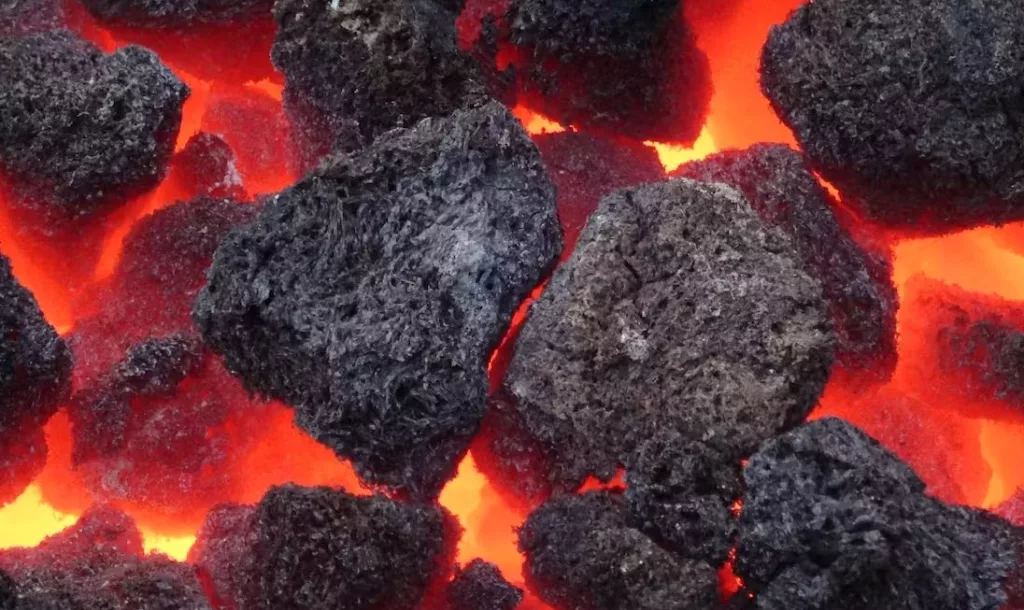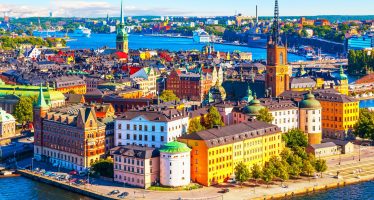Coal, Ja Bitte, Nuke, Nein Danke: Germany’s Other Sort of Nuclear ‘Disaster’ is Unfolding
Coal is a dirty source of fuel, and brown coal is the worst of the lot — yet, as Wim Romeijn reports, that’s what nuclear-shy Germans have opted for…
Around the time Germany shuttered its last three nuclear power plants, five lignite-burning ones were recommissioned. In North-Rhine Westphalia, energy producer RWE Power began dismantling a wind farm — to make way for the expansion of an open-pit lignite mine.
The company wants to excavate an additional 20 million tonnes of brown coal at its Garzweiler II mine. In the Rhenish mining area, comprising three lignite-rich seams west of Cologne, six villages are slated for demolition to get access to the low-grade coal that lies beneath them. The razing of Lützerath, a bucolic village which in its 900-year history never boasted more than 105 inhabitants, sparked pitched battles between climate protesters and riot police. Environment champion Greta Thunberg showed up — only to be arrested.

The other five villages due for demolition had a last-minute reprieve under a tentative plan to limit the Garzweiler II expansion. Morschenich was one of those spared, and it now houses refugees from Ukraine and Syria. The original inhabitants had already been resettled, but the “revived” town has no shops — although a bus service was re-established, and utilities reconnected.
Dirtiest Coal
Lignite is the most polluting form of coal. It is crumbly and has a high moisture content. That means inefficient combustion and carbon emissions of up to 1,250 grammes per generated kilowatt-hour.
Germany chooses it because it is cheap, and mined near to powerplants. The ruling coalition of Social-Democrats, Greens, and Liberals had promised to phase-out lignite by 2030; that goal was sacrificed to the economy.
Germany’s second-largest electricity producer, Leag, operates four open-pit lignite mines to feed its four power plants. But it has offered some good news: it intends to morph its vast landholdings in Lower Lusatia, Brandenburg, into Europe’s biggest wind and solar farm.
So far, the ambitious plan has mostly generated scepticism. The company is owned by Czech business tycoon Daniel Křetínský, who made his fortune by backing a hunch that Europe’s stated targets for the fossil-fuel phase-out were over-ambitious. It snapped up cheap coal assets in Slovakia and Italy.
Křetínský’s contrarian streak — he delights in running counter to market sentiment — may be at play here. The entrepreneur has begun construction of a combined wind and solar park covering 11,500 hectares. It is slated to put out 7GW of clean energy — and double that by 2040.
But Germany’s Energiewende (energy transition) is in trouble. Passed into law in 2010, the bold attempt to build the world’s first major renewable energy economy has struggled to find alternatives to coal (dirty) and natural gas (unsavoury).
The German people, nominally climate-conscious, seem at a loss. They are long on perceived problems but short on realistic solutions. Even wind power suffers from NIMBY (not-in-my-backyard) opposition.
The Energiewende was expected to slash carbon emissions by as much as 90 percent and up the share of renewables to 60 percent. And then, a year later … the Fukushima disaster. That caused then-chancellor Angela Merkel to lose her cool. In a moment of panic, disguised as decisiveness, she ordered the shutdown of the country’s 17 nuclear powerplants. Eight reactors were taken offline, with the remainder ordered to shut by 2022. The last facility was pulled offline in March this year.
In fairness, Merkel was only rekindling a policy initiative first framed her predecessor, Gerhard Schröder. His Social Democrat-Green coalition decided in 2009 decided to wean the country off nuclear.
So Germany turned to lignite and hard coal, which together generate 31 percent of national output, up from 23.4 percent in 2020. While renewables — wind, solar, geothermal, and biomass — represent an impressive 44 percent of the 571 billion kWh produced in 2022, the share of clean energy has remained fairly constant over the past five years.
Nuclear Phobia
The Germans’ fear of all things nuclear has proven expensive. Households face the second-highest energy prices in Europe (after Ireland). At almost 56 eurocents per kWh, consumers in Germany pay twice the EU average. Industrial users pay considerably more.
In France, a kWh, including taxes, averages about 20 eurocents — for residential and industrial users. The country is peppered with nuclear powerplants: 56 at last count, although a number are offline for maintenance. Still, the country derives 70 percent of its electricity needs from nuclear. President Emmanuel Macron recently announced plans for six new high-power reactors, with an option for eight more.
France embraced nuclear power in the 1970s, after OPEC quadrupled the price of oil. In 1974, then-prime minister Pierre Messmer appeared on national television to unveil his “all nuclear, all electric” plan. Over the next 15 years, 48 reactors were built at 12 plants.
The plan worked too well. It had called for the construction of 170 reactors, but by 1990 — with only 50 in operation — nuclear was already providing 75 percent of the country’s needs. France simply had too much power, with its plants operating at just 61 percent of capacity. Carbon emissions from power generation have dropped by two-thirds since 1974.
For all its dedication to climate neutrality, Germany generates just 44 percent of its electricity via clean sources — against 93 percent for France. While Germany has earmarked close to €550bn (£478bn) for the Energiewende up to 2026, France retook top spot as the European Union’s largest electricity exporter in January. It had been temporarily displaced by Sweden, as older French reactors suffered outages.
Scandi Pivot
Sweden was one of the first countries to have a stab at eliminating nuclear power. In the 1980s, it had planned to phase out nuclear by 2010. The government banned nuclear research, outlawed the recommissioning of closed reactors, and slapped a SEK3.30/kWh (£0.24/€0.28) tax on nuclear energy; that doubled in 2006. The tariff forced the closure of two of the four Ringhals reactors in 2020, and the surcharge was largely scrapped in 2017.
In 2021, state-owned energy company Vattenfall found that abolishing the remaining nuclear tax would deflate its generating cost to just SEK221/MWh (£16.40/€18.8), or about two-thirds of the current wholesale price. After taxing nuclear power into a coma, the Swedish government reversed course to grant the industry SEK443bn (£33bn/€38 bn) for the development of new reactors. It has proposed the resurrection of the mothballed Ringhals plants, and shortened the permit process for new ones.
Growth Market
France is determined to cash-in on the renewed interest in nuclear with its European Pressurised Reactor (EPR), a third-generation reactor being redesigned for improved performance, lower construction costs, and improved safety.
Outside China — which built the first EPR, Taishan I — the design has suffered from budget blowouts and commissioning delays. Initially estimated to cost around €3.7bn (£3.2bn), the French-designed Olkiluoto 3 reactor in Finland came in three times over budget and 14 years late. With the EPR2 and the smaller EPR1200 under development, France expects to retake the lead in design, and claim its share of the 300 or so new nuclear power plants planned globally.
Infuriating King Coal
“People continue to plan and build and burn unmitigated, unabated fossil fuel,” US climate envoy and former secretary of state John Kerry has said. He’s upset over the scale of coal-power expansion in Asia.
China and India burn 70 percent of the world’s coal, according to data from the International Energy Agency (IEA). In 2020, President Xi Jinping of China promised that his country’s carbon emissions would peak in 2030 before reaching net zero by 2060. Indian PM Narendra Modi pledged net zero by 2070, without going into specifics.
Trying in vain to hammer out preliminary agreements for the upcoming COP28 climate summit in Dubai, Kerry vented his frustration that global energy-related CO2 emissions grew by 0.9 percent last year to set a new record at 36.8 Gt. In a post-pandemic rebound, emissions ballooned by six percent in 2021. The silver lining noted by the IEA is that the pace of emissions growth was slower than expected.
Kerry says the commissioning of new coal-fired plants in Asia negates the carbon reductions achieved in Europe and North America. Globally, more than 200 coal-burning powerplants are under construction, with another 350 in the pre-construction and planning stages.
“Despite all the consequences, we are not yet doing what we said we would do,” said Kerry, ascribing the disparity to “fundamental, basic greed”.
You may have an interest in also reading…
What You Need to Know About Stockholm+50
On 2 and 3 June 2022, world leaders and representatives from government, business, international organizations, civil society and youth will
Lord Waverley: New Thinking in the UK
New Thinking in the UK, Commonwealth Advantage and the Electronic Trade Documents Bill Whilst it is undeniable that we are
Joe Biden No Panacea to Global Trade Troubles
The imminent departure from the White House of the self-styled dragon-slayer does not necessarily bode well for Chinese President Xi


















































































